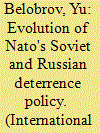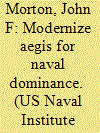| Srl | Item |
| 1 |
ID:
174514


|
|
|
|
|
| Summary/Abstract |
IN 2019, the NATO countries celebrated the 70th anniversary of their military alliance with great fanfare. A common theme of the anniversary celebrations and NATO leaders' related public statements, as well as the London Declaration that the leaders of the NATO countries adopted at a meeting in London on December 3-4, 2019, is the idea that NATO is indispensable to maintaining security in the Euro-Atlantic region and the world as a whole, and that the policy of resolutely deterring Russia must continue. Even though the wording of the bloc's strategy has changed as the international situation and relations with the USSR/Russia change, that key element has remained a constant, fundamental principle of all seven strategic concepts and other basic documents of the alliance throughout its entire existence.
|
|
|
|
|
|
|
|
|
|
|
|
|
|
|
|
| 2 |
ID:
130758


|
|
|
|
|
| Publication |
2014.
|
| Summary/Abstract |
Missile-defense capabilities on board U.S. Navy cruisers and destroyers can be updated in the future without the requirement to build new ships.
The surface Navy has a strong argument that the Department of Defense strategic guidance and the rapidly changing security environment fully support Aegis modernization plans. Modernized Aegis warships are critical naval assets for overseas commanders-even more so when cost-effectively upgraded with the capability for integrated air and missile defense (IAMD). Expedited deployment of this next-generation capability will boost near-term readiness and further solidify U.S. maritime dominance. Modernized Aegis warships are the combatant commanders' guarantors of globally integrated joint-force operations for joint access-the sharp edge of the nation's 21st-century deterrence policy.
|
|
|
|
|
|
|
|
|
|
|
|
|
|
|
|
| 3 |
ID:
083232


|
|
|
|
|
| Publication |
2008.
|
| Summary/Abstract |
This study provides an explanation of terrorism by examining interactions between the terrorist group with a minority as a potential pool of recruits and the government supported by a majority. A hawkish deterrence policy makes it more risky for terrorists to launch attacks, but heightens the anti-government feeling of the terrorist group. In addition, the payoff for the government depends not only on the payoff loss associated with the level of terrorism, but also on the political payoff from the action itself of adopting a hawk policy due to its politicians' vested interests. We first show that whether the deterrence policy should be 'hawk to 'dove is closely dependent on the relationships among the risk associated with terrorism, the anti-government feeling of the terrorist group, and the political payoff for the government. This study then introduces transnational support enhancing the capability of a terrorist group to intensify its activity and shows that the emergence of transnational support may cause the government to reform its deterrence policy from 'dove' toward 'hawk,' with terrorism intensified in the society
|
|
|
|
|
|
|
|
|
|
|
|
|
|
|
|